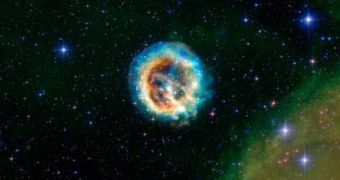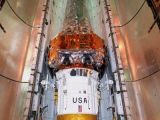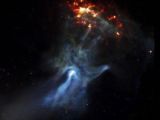This very day a decade ago, NASA was celebrating the successful launch of its third Great Observatory, the Chandra X-ray Space Telescope, which was delivered to orbit by the ill-fated space shuttle Columbia, during the STS-93 mission. The TRW Inc. and Northrop Grumman-built instrument took off on July 23rd, 1999, from the Kennedy Space Center, in Florida, and was scheduled to remain in its peculiar orbit for five years. Now, after more than ten years, its expected life span has been extended “based on the observatory's outstanding results,” as the Marshall Space Flight Center puts it.
“Chandra's discoveries are truly astonishing and have made dramatic changes to our understanding of the universe and its constituents,” the NASA Project Scientist at the Flight Center, Martin Weisskopf, says on the occasion. “The Great Observatories program – of which Chandra is a major part – shows how astronomers need as many tools as possible to tackle the big questions out there,” NASA's Science Mission Directorate Associate Administrator Ed Weiler, from the agency's headquarters, in Washington, DC, adds. The other components of the Great Observatories are the still-operational Hubble and Spitzer space telescopes, as well as the now-decommissioned Compton Gamma-Ray Observatory.
“I am extremely proud of the tremendous team of people who worked so hard to make Chandra a success. It has taken partners at NASA, industry and academia to make Chandra the crown jewel of high-energy astrophysics,” the Director of the Chandra X-ray Center at the Smithsonian Astrophysical Observatory, Harvey Tananbaum, shares. To celebrate the anniversary, NASA will re-release a series of three classical Chandra photos, which will provide an even more extended view of the craft's earlier discoveries. The first of them, an image of the exploded star E0102-72, is available today.
Among the most important finds that Chandra made, the reason why it is said that its contribution to the field of astronomy is priceless, is the fact that dark matter must exist. Surveys of galaxy clusters, conducted in collaboration with optical telescopes, have determined that the universe contains six times as much dark matter as normal matter. Dark matter is revealed through its gravitational pull on normal matter such as electrons and protons, but has so far escaped detection by any type of telescope.
Though it's difficult to sum up ten years of continuous observations and affiliated research in a classification, here are some of the most important discoveries made by Chandra:
1. The first X-ray emission was seen from Sagittarius A, the supermassive black hole at the center of our galaxy; 2. More cool gas than expected was found spiraling into the center of the Andromeda Galaxy; 3. The first time the shadow of a small galaxy as it is being cannibalized by a larger one was revealed in an image of Perseus A; 4. A new type of black hole was discovered in galaxy M82, possibly the missing link between stellar-sized black holes and supermassive black holes; 5. Sound waves from violent activity around a supermassive black hole were observed in the Perseus Cluster; 6. X-ray emitting loops, rings and filaments were found around a supermassive black hole within Messier 87, implying the presence of pressure waves, shock waves and sound waves.
The telescope also observed, for the first time, binary black hole systems, at the center of a galaxy that formed after the collision of two smaller ones. Chandra observations have delineated the shock waves generated by supernovas and made it possible to measure the velocity of the shocks. These measurements provide the best evidence yet that supernova remnants are the primary source of cosmic rays, extremely energetic particles that permeate the Galaxy and continually bombard Earth’s upper atmosphere.
Other images of the Crab Nebula and dozens of other supernova remnants have revealed spectacular rings and jets surrounding a central neutron star and, embedded in glowing, magnetized clouds of energetic particles called pulsar wind nebulas. Finally, the Chandra X-ray Telescope discovered that young, Sun-like stars with ages between one and ten million years produced violent X-ray outbursts, or flares, that were much more frequent and energetic than anything seen today from our present-day Sun.

 14 DAY TRIAL //
14 DAY TRIAL // 

